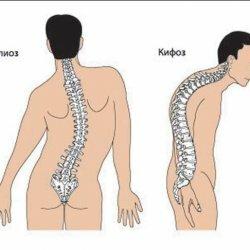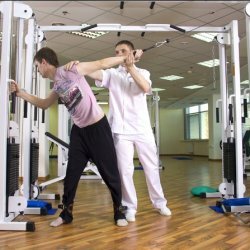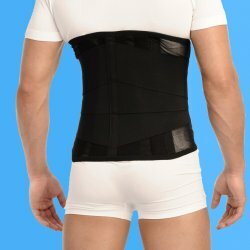Kifoz of the spine - what is it dangerous and how to treat it?
 Diseases of the musculoskeletal system are found in almost all people. One of them is the kyphosis of the spine, that is, its curvature. Normally, the healthy spine is slightly curved, but this curvature should not exceed 20-40 degrees. If this figure is higher than normal, a kyphosis of the thoracic region is diagnosed in the person( this is the most common type of curvature of the spine), characterized by the formation of a small, protruding abdomen and a hollow sternum.
Diseases of the musculoskeletal system are found in almost all people. One of them is the kyphosis of the spine, that is, its curvature. Normally, the healthy spine is slightly curved, but this curvature should not exceed 20-40 degrees. If this figure is higher than normal, a kyphosis of the thoracic region is diagnosed in the person( this is the most common type of curvature of the spine), characterized by the formation of a small, protruding abdomen and a hollow sternum.
Most often it is observed in boys during puberty, when the muscles simply "do not have time" to grow behind the bones and pull them down. As a result, the teenager begins to stoop strongly. But there is often kyphosis in adults.
Types of kyphosis of the spine
- Cervical kyphosis - curvature of the cervical spine. It often occurs in infants who injured the neck during labor and causes the greatest fears for doctors, since it can disrupt blood circulation and lymph circulation, which sometimes leads to brain damage and fraught with the development of mental illnesses. Its complication in the absence of timely, correct treatment is osteochondrosis( fragility of bones).
- Breast kyphosis, as described above, is a very common disease of the thoracic region. Its complication may be a hump, a reduction in the breast( shoulders lowered, breasts sunken), and then - destruction of the intervertebral cartilage. Over time, not only the bone system suffers, but also the muscular system.
- Lumbar kyphosis speaks of the bending of 1 or 2 of the two lumbar vertebrae. In this case, the waist acquires a rounded shape, while the bend of the spine disappears. This is a huge load on unused to her joints, which leads to loss of elasticity of the spine.
Physiological and pathological syndromes of kyphosis of the spine
Physiological is the lighter form of kyphosis, as when lying on an even surface the bend is leveled. It is present in all people and is not a disease.
Pathological - a curvature of more than 45 degrees, which is diagnosed as a disease and requires immediate treatment.
Conditions for kyphosis of the spine
- Postural( or sedimentary) kyphosis is the result of incorrect posture for a long time. Suffer them, mainly, men under the age of 30, who slouch and lead a sedentary lifestyle. Subsequently, the person begins to lean forward. This kind of kyphosis is the easiest of all, so it does not require treatment by a specialist, as it can be corrected independently, by starting to move more actively, hanging on a horizontal bar and watching your posture, the irregularity of which a person often does not notice while walking.
- The dorsal juvenile kyphosis has another name - Sheyerman's disease Mau. It is characterized by a narrowing of the anterior part of the vertebrae, acquiring the shape of a knife. For this reason, the kyphosis of the thoracic region is formed. Why does the disease occur? Until now, scientists are trying to figure this out, while stopping at the opinion that genetics is to blame.
- Congenital kyphosis. If a child was born with an incompletely formed spine, then this is the cause of the spine kyphosis in the future. In this case, the systematic urination is disrupted, in severe cases, paralysis of the lower extremities is possible. Therefore, this form of kyphosis is treated with the help of a surgeon.
- Postoperative kyphosis, as the name implies, is the result of non-compliance with medical recommendations.
- Posttraumatic kyphosis develops after a spinal injury. Progressing kyphosis causes compression of the nerve endings, which causes compression kyphosis.
- Degenerative kyphosis causes deformations occurring in the spinal column. Soon muscles and ligaments supporting the spine are weakened.
Other causes of acquired spinal kyphosis
- rickets
- spinal cord muscle paralysis
- tuberculosis
- "senile" kyphosis
Symptoms of spine kyphosis
The most common symptom, which, however, the diagnosis is difficult to determine, is back pain. This pain is caused by a muscle spasm.
The following symptom is the weakness that occurs due to compression( i.e., compression) of the spinal cord or nerve roots. Against this background, patients also experience numbness of the legs and hands, pelvic disorders.
Possible development of violations in the work of pulmonary and cardiac systems, as well as the formation of a hump in very neglected cases.
Diagnosis of kyphosis of the spine
But the doctor can not diagnose only on the basis of these symptoms. First of all, he must conduct a conversation with the patient to find out whether the manifestation of the disease is possible due to heredity, where the pain is localized, whether there were any operations on the spine. Also, the doctor must determine the strength of the muscles, reflexes( knees, Achilles and plantar reflexes), motor function.
Treatment of kyphosis of the spine
Distinguish conservative and surgical treatment, which is carried out in the late stages of the disease, when conservative treatment did not help or carry it out late due to neglect of the disease.
Conservative treatment includes drug therapy, exercise therapy, manual therapy. Wearing corsets also refers to conservative treatment, but it should be noted that corsets are not always the best choice, since they can only worsen the situation by weakening the muscles constantly supported by them.
For the treatment of kyphosis, either manual therapy or massage is used, but not regularly - a few days before the next session a break is needed to get the muscles used. After the procedure, the patient feels pain, but this pain is an indicator that the muscles have earned, so you will have to suffer.
Therapeutic exercise is extremely important - it is exercises for the back and the press, which improve posture and strengthen weakened muscles.
Drug therapy consists of calcium and vitamin D preparations that help calcium absorption. If necessary, the patient takes painkillers prescribed by the doctor.
Operative( surgical) treatment
Indications for surgical treatment:
- If conservative treatment has not removed intense pain, the doctor will recommend surgery.
- Increased deformation forces you to resort to surgical treatment.
- Too obvious distortion, distorting the appearance of a person, makes it necessary to conduct surgical treatment.
Prevention of kyphosis of the spine
- Watch your posture, you can not stoop when walking and sitting.
- Be sure to do charging for the press and the spine.
- Help to improve the spinal exercises on the bar or swimming( by the way, swimming improves the functioning of the entire body, while not having contraindications, except for dirty, excessively chlorinated water).Of course, it is important to lead an active lifestyle, normalize nutrition and sleep, maintain the necessary level of vitamin D and calcium in your body.
Adhering to such simple rules, you will improve the condition of the whole organism, as well as prevent the diseases of the spine, which plays such an important and irreplaceable role in our lives.



